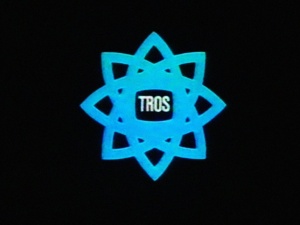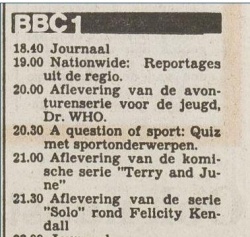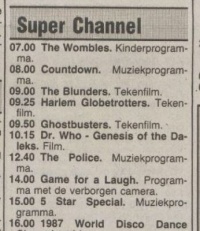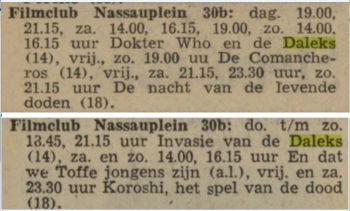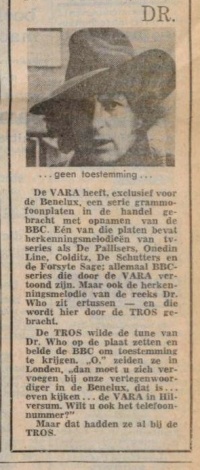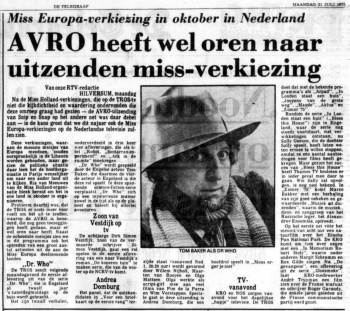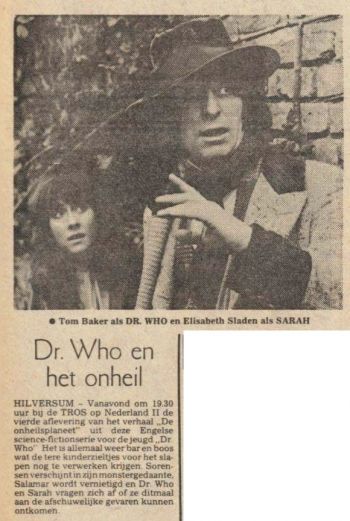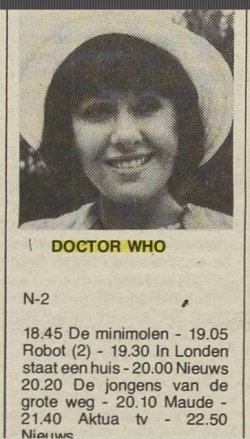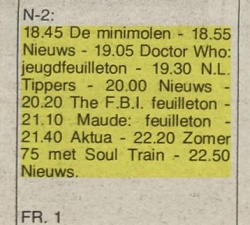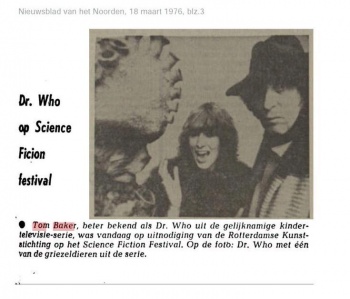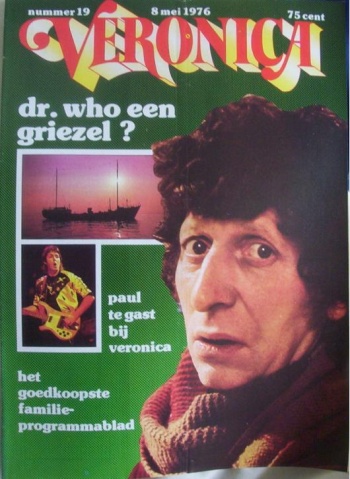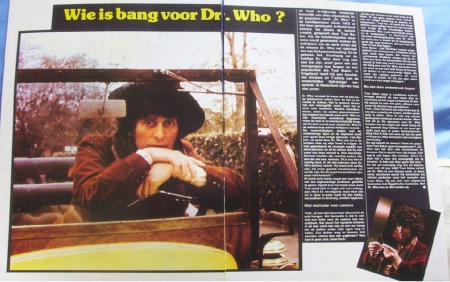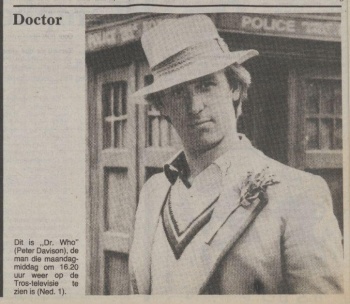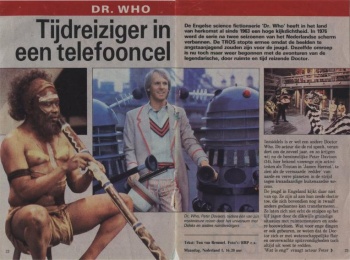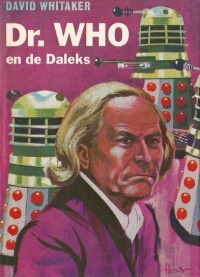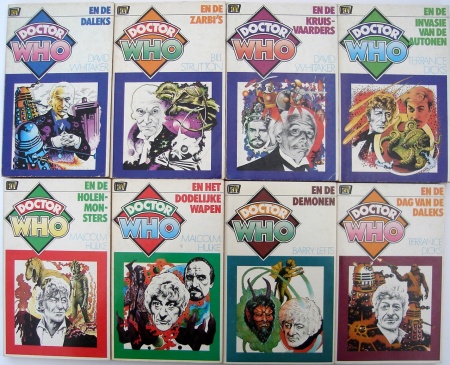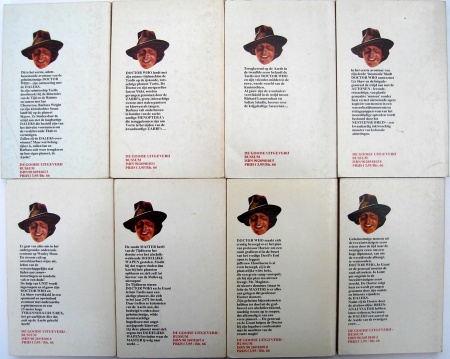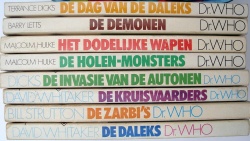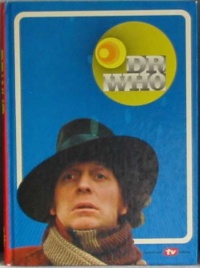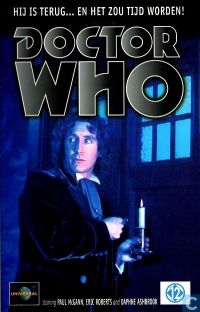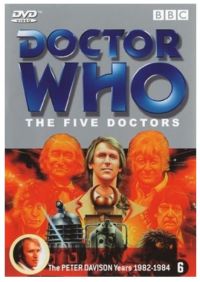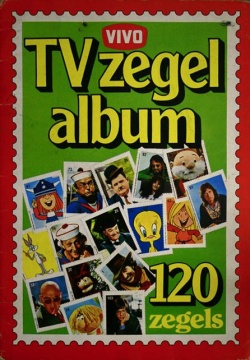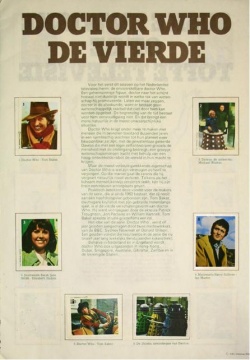Netherlands
The Netherlands (also known as Holland) is in west Europe, to the north of France.
Profile
| Country Number (37) | 1975 | SECOND WAVE |
| Region | Europe | |
| Television commenced | 1951 | |
| Colour System | 1968 | PAL |
| Population | 1974 | 13.4 million |
| TV Sets | 1974 | 4 million |
| Population | 1984 | 14.25 million |
| TV Sets | 1984 | 6 million |
| Language/s | Dutch | Subtitled |
Television Stations / Channels
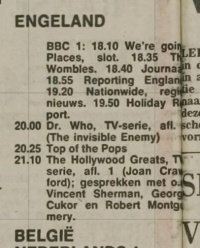
The Netherlands began its television service in 1951. By the mid-1960s, the country was served by five independent broadcasting associations, all of whom were controlled by the Nederlandse Televisie Stichting (NTS), which oversaw all programming. And although the five channels each had their own schedules, the NTS allowed them to go into partnership and broadcast the same programmes at the same time.
Colour transmissions began in 1968 using the PAL colour broadcast system.
Doctor Who aired on Televisie Radio Omroep Stichting (TROS) in two separate runs, starting in 1975 and 1985.
But residents of the Netherlands did have the opportunity to see Doctor Who by other methods:
BBC1 / BBC2
Under the right atmospheric conditions, and with specially adapted equipment (e.g. modified aerials) during the 1960s and 1970s, some lucky Dutch residents on the coast could pick up BBC transmissions across the English Channel, however, the signal quality was often quite poor. (From 1969, those with specially-built antenna (a hobby called DXing) could pick up the BBC2 625-line colour transmissions from the new Crystal Palace UHF transmitter.)
In the mid to late 1970s, a clearer BBC signal was available on the subscriber cable networks based in Amsterdam and the Hague which fed the western and northern provinces of the country; these networks received their transmissions from the antennae array on the Belgian coast (just east of Dunkirk in France) which fed the broadcasts into the Belgian, Dutch and Luxembourg cable systems via radio links. (The three together were known as "Benelux".) Since the UK transmitters were on the English coast, the continent also received signals from the ITV franchise holders Southern TV and Anglia TV.
As would be expected, the UK broadcasters and the various unions (such as Actors Equity) did not approve of British programmes being shown for "free" on foreign cable systems.
Some of the Dutch newspapers listed these unofficial UK broadcasts in their TV schedules! The northern Dutch newspaper Leidse Courant included BBC1 and BBC2 listings from time to time -- the earliest of which we found was from 8 December 1977, while another had the 31 December 1977 / 1 January 1978 repeat of The Robots of Death.
Regular but untitled listings for "Dr Who" on BBC1 can be found in northern-region Dutch newspapers from 1978 onwards, but only a few gave story titles, such as the one here for the 3 August 1978 repeat of The Invisible Enemy part 4.
By 1984, the complex copyright and residual payment issues had been settled which allowed BBC programmes to be shown officially on these European cable networks (under the "artistic work by wire" clauses) and for full BBC listings (and later those of ITV station Anglia TV) to be published in foreign newspapers.
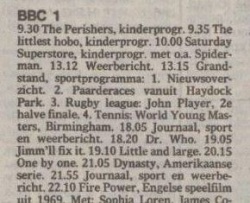 BBC1 was available "live" in the Netherlands via satellite and cable; listing for "Dr Who" at 18.20pm on 5 Jan 1985 (Attack of the Cybermen part 1); De Volkskrant |
BFBS
From late 1980, Doctor Who was also available to viewers in the border regions that could receive BFBS (British Forces Broadcasting Service) signals from garrison stations in the lower south-west of the British Sector of West Germany.
The south-eastern province of Limburg was able to receive (albeit illegally!) the BFBS signals on local channels 40, 49 and 50. Since channel 40 was also used by the German station SWF3, in order to pick up the BFBS signals, Dutch viewers installed special inverters to receive the audio and by angling their TV aerials horizontally they could pick up the image.
A few years later, the BFBS channel was formally available in Limburg and elsewhere via the country's growing cable network.
As had been the case with the BBC listings, the Dutch newspapers were not permitted to publish BFBS TV schedules either, however this restriction was eventually lifted, and regional papers began including the military channel's schedules in TV guides, such as the Limburgsch Dagblad which first printed the BFBS listings in August 1982.
- See our dedicated BFBS pages for more details
SATELLITE
Both BBC 1 and BBC 2 were eventually available direct from the UK via satellite; the Colin Baker and Sylvester McCoy stories could be seen "live" from 1985 to 1989 in most areas.
Doctor Who later became available throughout the Netherlands on the UK-based satellite station Super Channel from 24 March 1987, and from November 1989 it was seen on West German station RTL.
BBC Prime was also available in the 1990s. Several US satellite channels also became available in western parts of Europe. Some of these also aired Doctor Who or the Peter Cushing movies.
Language/s
The principal language of the Netherlands is Dutch, however English is also in common usage. Foreign television programmes are broadcast with their original audio language, with Dutch subtitles.
DOCTOR WHO IN THE NETHERLANDS / HOLLAND
In terms of a Dutch station purchasing the series for local transmission in 1975, the Netherlands was the 37th country to screen Doctor Who, but the first in Continental Europe (see Selling Doctor Who).
It was also the very first country to air the early Tom Baker stories, playing season 12 only seven months, and season 13 only a few months after the original UK broadcasts - well ahead of Australia! In fact Planet of Evil aired on TROS only two months after its UK screening.
DALEK MOVIES
PETER CUSHING Movies
The two Cushing Dalek movies didn't reach Dutch cinemas until the mid-1970s; and it was only in small suburban niche theatres rather than on general release.
Both were shown at the Filmclub Nassauplein - a "Living Room" cinema - located in Groningen, the Hague: the earliest listing we found for the second film - "Invasie van de Daleks" - was 18 October 1973, while the earliest for the first - "Dokter Who en de Daleks" - wasn't until the following year, from 28 February 1974. (Note: these screenings are the earliest we found using OCR; but both films may have actually appeared prior to these dates.)
The two also had several return screenings in later years, including during SF Film Festivals.
Both films also screened on Dutch television several times in the 1980s.
The first film later appeared on the Netherland's Sci-Fi channel (launched in May 2007, previously Sci-Fi Benelux, and also available in Belgium) on Tuesday, 16 September 2008 (at 10.20pm) and again on Sunday, 21 September 2008 (11.50pm).
Aside from the Dalek movies, one of Holland's earliest exposures to Doctor Who was in the form of a hardback edition of the novelisation of The Daleks – see Novelisations below.
BBC Records
In a BBC memo dated 7 July 1965, "Holland" was one of several European countries to which the series had been offered. The stories auditioned were The Daleks, The Aztecs and The Sensorites, but no sale eventuated.
The reason why the series was not picked up can actually be traced back four months earlier: two Dutch newspapers - Het Vrije Volk and Algemeen Dagblad - reported in late March 1965 that a joint association of Dutch TV broadcasters was looking at Doctor Who to occupy a shared early evening timeslot on Fridays, starting in early April 1965. (As noted above, the Dutch TV channels could go into scheduling partnerships and deliver the same programmes on more than one channel at the same time.)
The newspapers reported that of the five stations (AVRO, VARA, KRO, NCRV and VPRO), only AVRO (Algemene Vereniging Radio Omroep) was keen on the new BBC science-fiction series for this shared slot, but since the others weren't as hot on it, the series was ultimately never acquired.
The Seventies records a sale of "(9)" stories to "Holland" by 28 February 1977. This figure is correct in terms of the number of Tom Baker stories that did air from 1975 to 1976.
The Eighties - THE LOST CHAPTERS records a sale of "(20)" stories to "Holland" (by 10 February 1987).
The November 1985 issue of the DWAS newszine Celestial Toyroom reported "The Dutch are trying Doctor Who again after a long break from the programme. Holland have bought the first twelve Peter Davison stories". However, that only nine Davison stories aired suggests that the reported figure of 12 was either wrong, or three additional Davison stories were also purchased but did not go to air.
The total in The Eighties might also be inaccurate, as it suggests there were 11 Davison stories in the sale.
In DWM issue 54 (July 1981), reader R E Ross from Rotterdam, reported on the 1975-1976 screenings in the Netherlands.
And in DWM issue 168 (November 1990) Patrick Bremmers's article "THE DOCTOR IN HOLLAND" presents a detailed overview of the 1975/76 and 1985/86 broadcasts of the series by TROS.
In DWM, Holland is identified in the story Archives of 17 of the stories named below; it is omitted from the Archive for 4A.
Stories bought and broadcast
TOM BAKER
Nine stories, 36 episodes:
| 4A | Robot | 4 | Robot | Robot |
| 4B | The Sontaran Experiment | 2 | Het Sontaran Experiment | The Sontaran Experiment |
| 4C | The Ark in Space | 4 | Het Ruimtestation | The Space Station |
| 4D | Revenge of the Cybermen | 4 | Der Wraak van de Cybermaten | The Revenge of the Cybermen |
| 4F | Terror of the Zygons | 4 | In de Greep van de Zygonen | In the Grasp / Grip / Clutches of the Zygons |
| 4H | Planet of Evil | 4 | De Onheilsplanet | The Evil Planet |
| 4J | The Android Invasion | 4 | Invasie der Androiden | Invasion of the Androids |
| 4K | The Brain of Morbius | 4 | Het Brein van Morbius | The Brain of Morbius |
| 4L | The Seeds of Doom | 6 | De Zaden van het Kwaad | The Seeds of Fear |
The Netherlands therefore bought GROUPs A and B of the Tom Baker stories, with the exception of two stories, Genesis of the Daleks and Pyramids of Mars, which did not screen, possibly due to censorship.
The programme was supplied as PAL colour video tapes with English soundtracks, which aired with Dutch subtitles.
The purchase of these serials may have been to ease the situation over BBC programmes having been shown for "free" on the Dutch cable network for several years (see above).
PETER DAVISON
Nine stories, 34 episodes (but not aired in the correct order):
| 5W | Four to Doomsday | 4 | Monarch | Monarch |
| 5X | The Visitation | 4 | Het Betzoek | The Visit |
| 5Y | Kinda | 4 | De Kinda | The Kinda |
| 6B | Earthshock | 4 | Aardshock | Earthshock |
| 6C | Time-Flight | 4 | Tijd-Vlucht | Time-Flight |
| 6E | Arc of Infinity | 4 | In Levensgevaar | Lives in Danger |
| 6D | Snakedance | 4 | Slangendans | Snakedance |
| 6F | Mawdryn Undead | 4 | Een Nieuwe Bedreiging | A New Threat |
| 6A | Black Orchid | 2 | De Zwarte Orchidee | The Black Orchid |
The Netherlands therefore bought GROUP A and part of GROUP B of the Peter Davison stories, with the exception of Castrovalva.
If the report in Celestial Toyroom is correct, two further Davison stories were purchased but didn't air -- Terminus and Enlightenment, perhaps?
The programme was supplied as PAL colour video tapes with English soundtracks, and broadcast with Dutch subtitles.
SYLVESTER McCOY
PAUL McGANN
TV Movie, 84 minutes:
| TVM | The TV Movie | 1 |
PATRICK TROUGHTON
One story, 10 episodes:
| ZZ | The War Games | 10 |
Transmission
TOM BAKER
On 21 July 1975, the Dutch newspaper De Telegraaf ran a short feature about upcoming series screening on TROS, including Doctor Who, illustrated with a photo of Tom Baker.
The series started on Monday, 28 July 1975, at 7.05pm, with Robot. The series aired at this time until 20 October when it changed to 7.30pm. As with all other screenings overseas, The Sontaran Experiment played before The Ark in Space.
Mid-way through Revenge of the Cybermen, from 3 November 1975, the series changed to screening fortnightly.
On 21 February 1976, the Dutch newspaper Het Parool ran a short piece about the series, complete with photo of Tom Baker (see above).
The 36 episode run ended on 20 September 1976 with part six of The Seeds of Doom.
As reported in DWM 54, the episodes rated well, reaching some 2.5 million viewers, with a rating of 78 out of 100 'points'.
Two Tom Baker stories were missed – Genesis of the Daleks and Pyramids of Mars – presumably on account of censorship. As had been reported in DWM 54 and DWM 168, the series was discontinued mainly on account of its violence, a position that many contemporary Dutch newspapers reported on at the time. This action may have been why the BBC subsequently found it difficult to sell the series elsewhere within Europe in the late 1970s – see Europe for more on this.
Baker attended the Science Fiction Festival, held in Rotterdam from 12 to 21 March 1976. This was publicized in the 18 March 1976 edition of Nieuwsblad van het Noorden.
The 8 May 1976 issue of Veronica magazine, featured an interview with Tom Baker, presumably conducted while he was visiting the country in March. Bizarrely, the article does not mention that the series was at the time screening on TROS! (The word "griezel" on the cover headline translates as "horror / scary / freak".)
It was during the 1975/1976 run that a series of novelisations and a Doctor Who Annual were translated into Dutch – see Novelisations below.
As noted above, some Dutch viewers could receive "unofficial" BBC transmissions from across the English Channel and/or on the cable networks, and from at least late 1977 were able to watch further episodes beyond the two seasons that were shown by TROS (albeit not subtitled). (The TV listings of the few available Dutch newspapers from that period have untitled listings for "Dr Who" in the 31 December 1977 / 1 January 1978 (which is the repeat of The Robots of Death), and in February 1978 (being The Invasion of Time). All subsequent series from Season 16 onwards have regular billings in the northern Dutch papers.)
And from late 1980, those Dutch provinces that bordered West Germany were able to receive signals from the BFBS military stations near Dusseldorf. BFBS screened episodes of Doctor Who a few weeks after the UK broadcasts. Dutch viewers within reception range (and with modified TV sets and aerials) could therefore watch Tom Baker stories in 1980 and 1981, Peter Davison's in 1982, 1983 and 1984.
By the mid-1980s, BBC1 was also available "live" by satellite, so Dutch viewers were able to view Colin Baker's first season from January to March 1985.
PETER DAVISON
After a nine year gap, TROS gave the series another go. From Monday, 30 September 1985, at 4.20pm, the Peter Davison era began, not with Castrovalva, but with Four to Doomsday. The next two stories aired in production code order.
Although all the Peter Davison stories had been seen "live" on the BBC in some northern regions of the Netherlands in 1982, 1983 and 1984, for most of the country, these episodes were 'new'.
The nine story run played at different times, ranging between 3.30pm and 4.47pm, which was considered to be very poor scheduling particularly considering the core audience would still be at school.
One of the stories to air was Arc of Infinity, which had its location filming undertaken and was partially set in Amsterdam.
The run ended on 7 July 1986, with both episodes of Black Orchid airing back to back (from 4.18pm to 5.05pm).
There were three weeks during this run when the series was pre-empted.
That was the last time Doctor Who was shown on Dutch television - however viewers with satellite access to BBC1 could watch new episodes "live", including The Trial of a Time Lord starting in September 1986, and all the Sylvester McCoy stories in 1987, 1988 and 1989.
And viewers in the south-eastern provinces that could access the British military station BFBS, could also see The Trial of a Time Lord (again!) from 1986 to 1987, and all three of Sylvester McCoy's seasons, 1987 to 1989.
The series was also available in the late 1980s via Cable and Satellite stations, such as Super Channel, which was received by most of Western Europe at the time. Dutch viewers were also able to view the German station RTL, which played dubbed Davison, Colin Baker and McCoy episodes between 1989 and 1995.
SYLVESTER McCOY
PAUL McGANN
The 1996 Paul McGann TV Movie was shown by the BFBS network on 25 May 1996.
The TV Movie was later released on Rental Tape VHS tape in 1997 -- see below. Two years later, the subtitled movie aired on TV: on 5 August 1999, at 10.36pm, on the Avro Netherlands channel.
PATRICK TROUGHTON
The second Doctor's final story, the 10-part The War Games was shown on the Dutch station ONS (launched in 2006, specialising in programmes for viewers aged 49 years and older).
The subtitled serial commenced on Tuesday, 13 October 2020 at 8.30pm, with a repeat on Saturdays (from 17 October) also at 8.30pm. Part 10 aired on 15 December 2020.
|
The War Games on ONS |
The story was repeated from Thursday, 11 March 2021 at the later time of 11.00pm, with a repeat at 8pm on Saturdays (from 13 March) and again on Mondays at 7.00am (from 15 March).
TV listings
| ← AIRDATES ...... (CLICK ICON TO GO TO TABLE SHOWING EPISODE BREAKDOWN AND AIRDATES - N/S = story title is Not Stated) |
TV listings have been obtained from DWM issue 168 (November 1990).
We are also indebted to the Dutch Fan Website for additional information:
This excellent site contains summaries of the Tom Baker and Peter Davison screenings – complete with newspaper clippings, rankings and audience figures for the stories that aired, as well as overviews of the other Doctors and the new series:
Also accessed were these online archived papers:
Merchandise
Novelisations / Annual
In 1966, Dutch publisher U M West-Friesland Hoorn released a hardback edition of David Whitaker's adaptation of The Daleks: DR WHO EN DE DALEKS.
While the Baker stories were airing, translations of eight of the Target Books novelisations were published by De Gooise Uitgeverij - Bussum / Unieboek BV–Bussum:
- DOCTOR WHO EN DE DALEKS (The Daleks) (this was a completely different translation to that of the 1966 hardback)
- DOCTOR WHO EN DE ZARBI'S (The Web Planet)
- DOCTOR WHO EN DE KRUISVAARDERS (The Crusade)
- DOCTOR WHO EN DE INVASIE VAN DE AUTONEN (The Invasion of the Autons) (Spearhead from Space)
- DOCTOR WHO EN DE HOLEN-MONSTERS (The Cave Monsters) (Doctor Who and the Silurians)
- DOCTOR WHO EN HET DODELIJKE WAPEN (The Lethal Weapon) (Colony in Space)
- DOCTOR WHO EN DE DEMONEN (The Daemons)
- DOCTOR WHO EN DE DAG VEN DE DALEKS (Day of the Daleks)
The facing title page carried the statement: "Gebaseerd op de BBC televisie-serie en in Nederland uitgebracht door de Tros-televisie", which means "Based on the BBC television series screened in the Netherlands by TROS-TV".
Although these novels feature the first, second and third Doctors, the back cover of all eight books features a portrait of Tom Baker; the artwork being cropped from the cover of Target's The Doctor Who Monster Book, which was published in November 1975. The translations themselves do not bear a date specific to the Dutch editions; although 1974 is stated on the copyright pages, that year is for the original UK editions.
The release date of the first two Dutch paperbacks can be narrowed down to June 1976: several Netherlands newspapers published "new books in the shops" previews which include Doctor Who en de Daleks and Doctor Who en de Kruisvaarders as new titles: the 1 June 1976 edition of Nederlands Dagblad, the 26 June 1976 issue of Leeuwarder Courant, and the 17 July 1976 Nieuwsblad van het Noorden mention the two David Whitaker adaptations.
As an example of the translated text, the familiar Dalek war cry is "WE ZULLEN JE VERNIETIGEN", which translates as "We will destroy you!"
Also released was a Dutch edition of the 1975 World Distributors annual. Published in November 1975 by Mulder & Zoon B.V., this volume had a slightly different cover layout than its English counterpart. The interior had virtually the same contents as the UK edition, but was translated into Dutch.
Video / DVDs
The TV Movie was released as a subtitled VHS tape by MCA/Universal/CIC Video in 1997. The tagline read "HIJ IS TERUG … EN HET ZOU TIJD WORDEN!" (He's Back ... And It Would Be Time!)
The 1999 DVD of the special re-edit of The Five Doctors had Dutch subtitles as an alternative language option. It's not known whether the disc was actually sold in the country, however the TV version of The Five Doctors was available six years later...
In 2006, 2007 and 2008, Memphis Belle International B.V. released three boxed sets of Classic stories on DVD. These were mostly the same as the UK releases but with the addition of Dutch subtitles. (Only some of the extras from the UK releases appeared on the Dutch discs.) The text on the covers and spines was in English, while the text on the backs and the inserts was in Dutch.
2006
2007
2008
Other Dutch Merchandise
In addition to the Veronica magazine (see above), and the translated novelisations, the only other known item of print merchandise relating to Doctor Who released solely in the Netherlands was this TV Zegel Album (TV Sticker Album), published by Vivo in 1976. Included in the 120 sticker set were six from Doctor Who, featuring the Doctor, Sarah, Harry, Davros and the Daleks, which could be mounted on the special DOCTOR WHO DE VIERDE (DOCTOR WHO THE FOURTH) page.
Netherlands/ Holland in Doctor Who
- The French were allied with the Dutch in their war with Spain (The Massacre).
- There was a Dutch crewman (Jim?) on the Gravitron base (The Moonbase).
- Euro Sea Gas engineer, Van Lutyens (John Abineri), came from The Hague (Fury from the Deep).
- Soldiers from the Three Hundred Year War fought in The War Games.
- The Doctor mentions Dutch painter Rembrandt in The Time Warrior.
- The Doctor mentions The Flying Dutchman in Underworld.
- On the wall of the TARDIS's ancillary power room was the painting Giovanni Arnolfini and his Bride by Dutch artist, Jan van Eyck (The Invasion of Time).
- The works of Dutch artist M. C. Escher inspired the look of and gave name to Castrovalva (Wikipedia entry).
- Arc of Infinity was filmed and set in and around Amsterdam.
